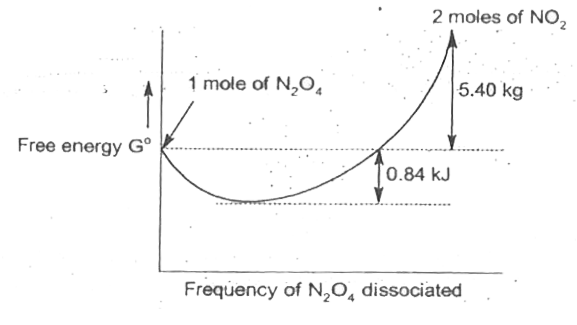Explain the state of a reaction when ΔG=0.
To explain the state of a reaction when ΔG = 0, we can break down the explanation into several steps:
1. Understanding ΔG:
- ΔG represents the change in Gibbs free energy of a system. It is a thermodynamic potential that measures the maximum reversible work that can be performed by a thermodynamic system at constant temperature and pressure.
2. Condition for ΔG = 0:
- When ΔG = 0, it indicates that there is no net change in the free energy of the system. This condition typically occurs when a reaction is at equilibrium.
3. Equilibrium State:
- An equilibrium state is reached when the rate of the forward reaction equals the rate of the backward reaction. In this state, the concentrations of reactants and products remain constant over time.
4. Example of Equilibrium:
- A common example is the melting of ice. At 0°C, ice (solid water) and liquid water exist in equilibrium. The rate at which ice melts into water is equal to the rate at which water freezes back into ice.
5. Implications of ΔG = 0:
- When ΔG = 0, it implies that the system is in a stable state where there is no tendency for the reaction to proceed in either direction. This means that the free energy, entropy, and enthalpy changes are all effectively zero for the equilibrium process.
6. Conclusion:
- In summary, a ΔG of zero signifies that the system is at equilibrium, and there is no driving force for the reaction to proceed in either the forward or reverse direction.
- ΔG represents the change in Gibbs free energy of a system. It is a thermodynamic potential that measures the maximum reversible work that can be performed by a thermodynamic system at constant temperature and pressure.
- When ΔG = 0, it indicates that there is no net change in the free energy of the system. This condition typically occurs when a reaction is at equilibrium.
- An equilibrium state is reached when the rate of the forward reaction equals the rate of the backward reaction. In this state, the concentrations of reactants and products remain constant over time.
- A common example is the melting of ice. At 0°C, ice (solid water) and liquid water exist in equilibrium. The rate at which ice melts into water is equal to the rate at which water freezes back into ice.
- When ΔG = 0, it implies that the system is in a stable state where there is no tendency for the reaction to proceed in either direction. This means that the free energy, entropy, and enthalpy changes are all effectively zero for the equilibrium process.
- In summary, a ΔG of zero signifies that the system is at equilibrium, and there is no driving force for the reaction to proceed in either the forward or reverse direction.
Topper's Solved these Questions
- THERMODYNAMICSBOOK - MODERN PUBLICATIONCHAPTER - THERMODYNAMICSEXERCISE - Revision Exercise (Short Answer Questions ) (Fill in the blanks : )
5 Videos
- THERMODYNAMICSBOOK - MODERN PUBLICATIONCHAPTER - THERMODYNAMICSEXERCISE - Revision Exercise (Short Answer Questions)
62 Videos
- THERMODYNAMICSBOOK - MODERN PUBLICATIONCHAPTER - THERMODYNAMICSEXERCISE - Revision Exercise (Assertion Reason Questions)
15 Videos
- STRUCTURE OF ATOMBOOK - MODERN PUBLICATIONCHAPTER - STRUCTURE OF ATOMEXERCISE - Unit Practice Test
13 Videos
Similar Questions
Knowledge Check
A reaction is spontaneous if free energy change ΔG , for the reaction is negative . The question arises, how we can explain , the spontaneous of reversible reaction taking the example of dissociation equilibrium N2O4⇔2NO2(g) the variation of free energy with the fraction of N2O4 dissociated under standard conditions is shown in the figure below.

When 1 mole of N2O4 changes into the equilibrium mixture the volume of ΔG∘ isA0.84 kJB−0.84kJC5.40 0.84 kJD0.84-5.40 kJA reaction is spontaneous if free energy change ΔG , for the reaction is negative . The question arises, how we can explain, the spontaneous of reversible reaction taking the example of dissociation equilibrium N2O4⇔2NO2(g) the variation of free energy with the fraction of N2O4 dissociated under standard conditions is shown in the figure below.

When 2 moles of NO2 change into equilibrium mixture the value of ΔG∘ isA(5.40+0.84)kJB(5.40−0.84)kJC(−5.40−0.84)kJD−5.40kJThe temperature in K at which ΔG=0 for a given reaction with ΔH=−20.5kJmol−1 and ΔS=−50.0JK−1mol−1 is
A−410B410C2.44D−2.44
What is an operon ? Explain the functioning of lac operon when in an open state.
View SolutionJustify the following statements :
(a)Reactions with ΔG∘<0always have an equilibrium constant greater than 1.
(b)Many thermodynamically enthalpy feasible reactions do not occur under ordinary conditions.
(c ) At low temperature , enthalpy change dominates the ΔG expression and at high temperatures, it is entropy whch dominatest the value of ΔG.
View SolutionComment on the following statements:
(a) An exothermic reaction is always thermodynamically spontaneous.
(b) Reaction with ΔG∘<0 always have an equilibrium constant greater than 1.
View SolutionAssertion (A): There is no reaction known for which ΔG is positive, yet it is spontaneous.
Reason (R ) : For photochemical reaction, ΔG is negative.
View Solution(A) Positive catalyst increases the rate of reaction
(R) Catalyst decrease the value of ΔG∘
View Solution
